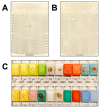FFPE-Based NGS Approaches into Clinical Practice: The Limits of Glory from a Pathologist Viewpoint
- PMID: 35629172
- PMCID: PMC9146170
- DOI: 10.3390/jpm12050750
FFPE-Based NGS Approaches into Clinical Practice: The Limits of Glory from a Pathologist Viewpoint
Abstract
The introduction of next-generation sequencing (NGS) in the molecular diagnostic armamentarium is deeply changing pathology practice and laboratory frameworks. NGS allows for the comprehensive molecular characterization of neoplasms, in order to provide the best treatment to oncologic patients. On the other hand, NGS raises technical issues and poses several challenges in terms of education, infrastructures and costs. The aim of this review is to give an overview of the main NGS sequencing platforms that can be used in current molecular diagnostics and gain insights into the clinical applications of NGS in precision oncology. Hence, we also focus on the preanalytical, analytical and interpretative issues raised by the incorporation of NGS in routine pathology diagnostics.
Keywords: NGS; biomarkers; diagnostics; precision medicine.
Conflict of interest statement
Umberto Malapelle received personal fees (as a consultant and/or speaker bureau) from Boehringer Ingelheim, Roche, MSD, Amgen, Thermo Fisher Scientifics, Eli Lilly, Diaceutics, GSK, Merck, AstraZeneca and Jannseen (unrelated to the current work). Nicola Fusco received honoraria for their consulting, advisory role and/or speaker bureau from Merck Sharp & Dohme (MSD), Boehringer Ingelheim, Novartis, AstraZeneca, and Daiichi Sankyo (unrelated to the current work). Fabio Pagni received honoraria for their consulting, advisory role and/or speaker bureau from Merck Sharp & Dohme (MSD), Novartis, Roche, and Amgen (unrelated to the current work). Matteo Fassan received research funding from Astellas Pharma, Macrophage Pharma and QED Therapeutics and had roles as a consultant or advisor for Astellas Pharma, Roche, Astra Zeneca, MSD and GSK-Tesaro (unrelated to the current work). All the other authors declare no conflict of interest regarding the publication of this article.
Figures



References
-
- Kerick M., Isau M., Timmermann B., Sültmann H., Herwig R., Krobitsch S., Schaefer G., Verdorfer I., Bartsch G., Klocker H., et al. Targeted High Throughput Sequencing in Clinical Cancer Settings: Formaldehyde Fixed-Paraffin Embedded (FFPE) Tumor Tissues, Input Amount and Tumor Heterogeneity. BMC Med. Genom. 2011;4:68. doi: 10.1186/1755-8794-4-68. - DOI - PMC - PubMed
-
- Deans Z.C., Costa J.L., Cree I., Dequeker E., Edsjö A., Henderson S., Hummel M., Ligtenberg M.J., Loddo M., Machado J.C., et al. Integration of next-Generation Sequencing in Clinical Diagnostic Molecular Pathology Laboratories for Analysis of Solid Tumours; an Expert Opinion on Behalf of IQN Path ASBL. Virchows Arch. 2017;470:5–20. doi: 10.1007/s00428-016-2025-7. - DOI - PMC - PubMed

